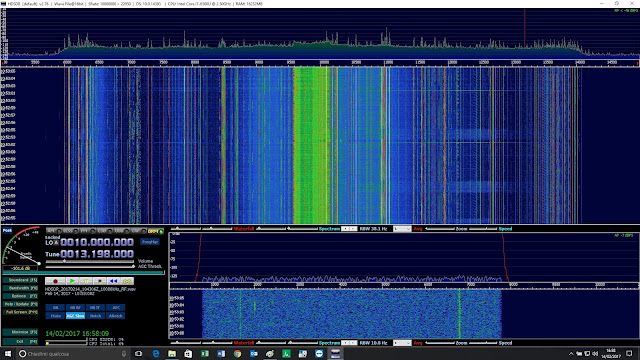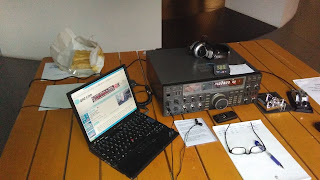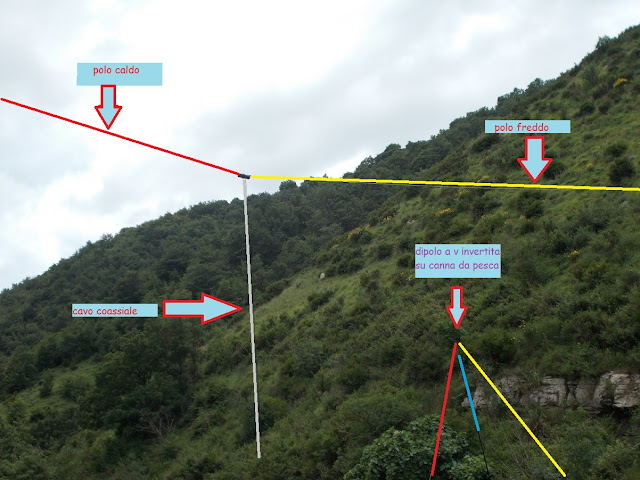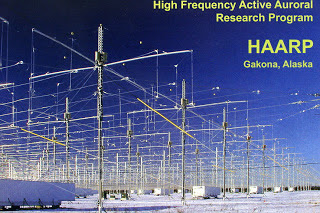Facendo seguito alle pubblicazioni agli indirizzi :
http://air-radiorama.blogspot.it/2016/08/parzialmente-risolto-il-mistero-delle.html
http://air-radiorama.blogspot.it/2017/02/ancora-novita-sulle-scalette-ladders-in.html
mi sono dato da fare questa volta a registrare non solo gli spettrogrammi , ma anche il segnale RF I&Q .
Con alcune ottimizzazioni ed il determinante l'aiuto di Oscar Steila ( che ringrazio meglio al fondo assieme ad altri notevoli personaggi) sono arrivato a registrare circa 8 MHz di banda utile ( tra 6 e 14 MHz ) con un disco veloce da 1TB , per una durata complessiva di circa 6 ore .
Durante questo ho pescato fortunosamente dal mio QTH una di queste scalette e sono riuscito ad analizzarla in tempo reale .
Si tratta di una di quelle che ho definito con " gradini corti ".
E' un segnale che sale a passi discreti di 100 kHz ad intervalli ogni 3 secondi e staziona sulla frequenza per tre secondi .
L'andamento e' ben visibile al di sopra della riga gialla che ho disegnato sull'immagine.
Following the post at the links :
http://air-radiorama.blogspot.it/2016/08/parzialmente-risolto-il-mistero-delle.html
http://air-radiorama.blogspot.it/2017/02/ancora-novita-sulle-scalette-ladders-in.html
I recorded not only the spectrograms ( waterfalls ) , but also the RF signal I&Q .
With some tricks and with the help of Oscar Steila , I was able to record around 8 MHz of effective BW ( between 6 and 14 MHz ) with a high speed HD of 1TB , for a total time of around 6 hours .
During this time I have luckily found one of this ladders that I then analyzed in real time .
It is a ladder that I defined in the previous posts " ladders with small steps ".
It is a signal that jumps in step of 100 KHz very 3 sec ( and lasting on the same frequency for 3 sec ).
It is very easy to see over the yellow diagonal line I have draw for reference ) .
Please click on the image if you want to expand it .
Di seguito il passaggio sullo spettrogramma superiore che e' stato velocizzato e la demodulazione a 8 MHz (spettrogramma inferiore).
Non ha modulazione e quindi si tratta solo di portante .
E' affetta da QSB e quindi non si tratta di un segnale locale .
In the following image some steps of the ladder can be seen having increased the speed of the waterfall .
In the lowed ( demodulated waterfall ) there is the signal demodulated .
It is only carrier ( no modulation ) and you can see that this segment is affected from QSB during the 3sec where it last at 8 MHz ) on the lower waterfall .
Ho seguito passo per passo tutti i segmenti fin dove possibile .
Sul lato inferiore sono arrivato fino a 5.9 MHz , impossibile vedere piu' sotto perche' il filtro digitale configurato sul convertitore A/D non lo consentiva , ma sicuramente il tutto parte da molto piu' in basso perche' a 5.9 MHz il segnale demodulato era ancora molto intenso .
Sul lato superiore sono arrivato fino a 13.2 MHz , prima che il successivo segnale scomparisse totalmente nel rumore per avere superato la MUF ( Maximum Usable Frequency ) di quel momento .
Il tutto e' visibile nello spettrogramma inferiore delle immagini .
Ho usato per comodita' la funzione demodulazione DRM perche' alla fine e' una USB a larga banda .
Nella prima immagine si vede in alto la portante e la modulazione della Broadcasting a 5905 kHz
( Radio China International ?)
I have then followed and demodulated all the possible steps .
On the lower band I arrived till 5.9 MHz . Impossible to go lower due to the digital filter of the A/D converter .
On the upper band I was able to arrive till 13.2 MHz before the attenuation of the MUF ( Maximum Usable Frequency ) buried the signal into the noise .
This can be seen in the two following images .
In the first image ( lower waterfall ) you can also seen the carrier and the modulation of a Broadcasting at 5905 kHz ( Radio China International ?)
La spiegazione piu' logica e' che si tratti di ionosonde che anziche' avere un andamento di scansione (sweep) continuo , hanno dei salti discreti di frequenza ,il che consentirebbe una serie di ovvi vantaggi.
Al momento parrebbe che non abbiano periodicita' come quelle standard .
Puo' darsi che vengano attivate al bisogno (usi militari ?) , oppure che facciano parte dei test HAARP o similari ?
Non sara' facile scoprirlo .
Sto indagando ulteriormente con altre registrazioni per vedere se ci sono casistiche di periodicita' particolari o meno .
Al momento non sembra ( perlomeno a breve termine ), ma posso ovviamente sbagliare .
The easiest explanation is that this are ionosonde with non continuous sweep .
At the moment I was not able to find that they are periodical like the normal ionosonde we know so far .
May be they are for military use on demand or test like HAARP or similar ?
Chiunque puo' comunque partecipare alla ricerca, anche con un semplice ricevitore in CW .
Consiglio di posizionarsi sulla frequenza di 8 Mhz che non e' ne troppo alta ne troppo bassa e piuttosto libera ( si sentono a volte voci in Francese ma in USB ) , qualche volta qualche burst dati veloce e poi , qualche volta al giorno, la portante che dura tre secondi .
Una volta ascoltata e terminata , si puo' seguire il seguito della scaletta avendo configurato un salto di frequenza di 100KHz in alto e facendolo fare a mano .
Le ore piu' favorevoli sembrano quella in cui il sole e' alto sull' Italia e fino a prima del tramonto .
Segnali dall'Ovest ? Sono pochissimo pratico di propagazione ....
Se avete dei dati e volete condividerli potete scrivere a : reclaudio@alma.it
Anyway everyone can partecipate to this research even with a simple standalone receiver in CW.
I suggest to use the frequency 8 MHz that typically is non used in CW .
As soon ad you hear the tone that last 3 sec ending , you can increase the frequency in 100 kHz step.
In Italy most favourable time looks when the sun is at the maximum elevation till sunset.
May be signals coming from West ?
If you want to share data send a message to :reclaudio@alma.it
Nel frattempo , intanto che riproducevo i segnali registrati , ne ho trovati altri di natura diversa che chiamero' " fantasmi " ( ghosts ) .
While I was playing the signal recorded I have seen other signals that for the moment I will call "ghosts " ( se following pictures )
Questi sembrerebbero avere modulazione ,su banda relativamente larga , probabilmente digitale .
Si tratta quasi sicuramente delle " digisonde" che sono ionosonde con modulazione digitale , anche qui i salti sono discreti .
Per pura combinazione nella prima immagine si vedono in parallelo una ionosonda "normale" ( probabilmente Cipro) ed una di queste.
Nella seconda immagine si vede sempre la ionosonda che appare prima debole nel tratto inferiore di frequenza e poi scompare ( per ricomparire poi bene nella prima immagine ) .
Appena avro' tempo vedro' di analizzare anche i "ghost" .
They looks to have modulation on a relatively large BW , probably digital .
I would say that they could be what are called " digisonde" , but need further investigation .
In the first picture you can see one and graphically in parallel ( over ) a normal ionosonde ( may be Cyprus ? )
Vorrei ringraziale pubblicamente Oscar Steila che si e' dannato l'anima per fare funzionare un convertitore A/D da 54 Ms e 16 bit e consentire la registrazione e riproduzione tramite HDSDR con dei PC allo stato dell' arte e con USB3.0 , ma non ..."militari" ....
Un altro ringraziamento va ad Alberto di Bene per avere reso pubblici i sorgenti del suo magnifico software Winrad che avendo un' architettura ottimale ed espandibile , ha generato una sequenza di magnifici software di cui il mio preferito e' ,come vedete, HDSDR .
Ovvi i ringraziamenti a Mario Taeubel ed a tutti quelli che lo hanno nel tempo aiutato a migliorare il software che ancora e' in evoluzione .
Un quarto ringraziamento ad Emanuele Pelicioli per avere messo a lungo e pesantemente messo mano da remoto sul PC impiegato per ottimizzare la velocita' degli 8 processori in gioco ....
Senza il loro aiuto non sarei mai riuscito a cavare un ragno ( anzi una scaletta ... ) dal buco ....
Many thanks to Oscar Steila , Alberto di Bene , Mario Taeubel and Emanuele Pelicoli that helped me in many stage of this endeavour .
Without them I will never get the recording of a ladder .















































